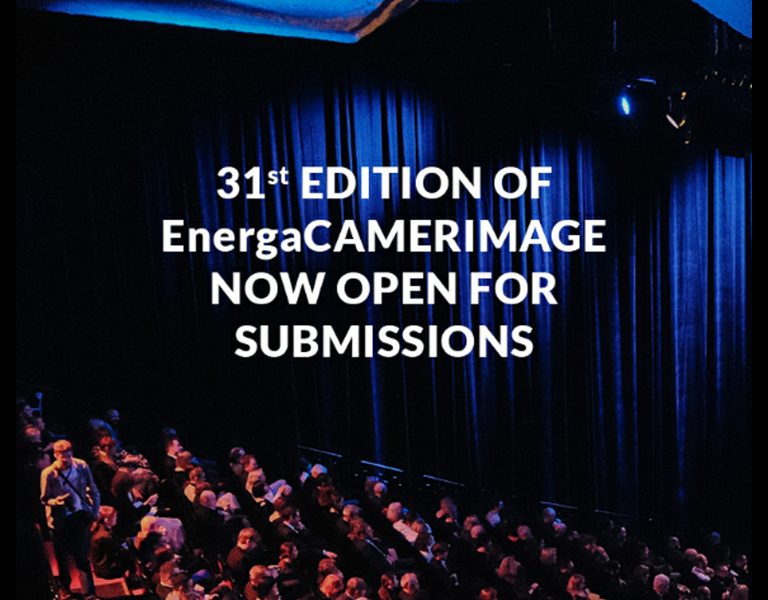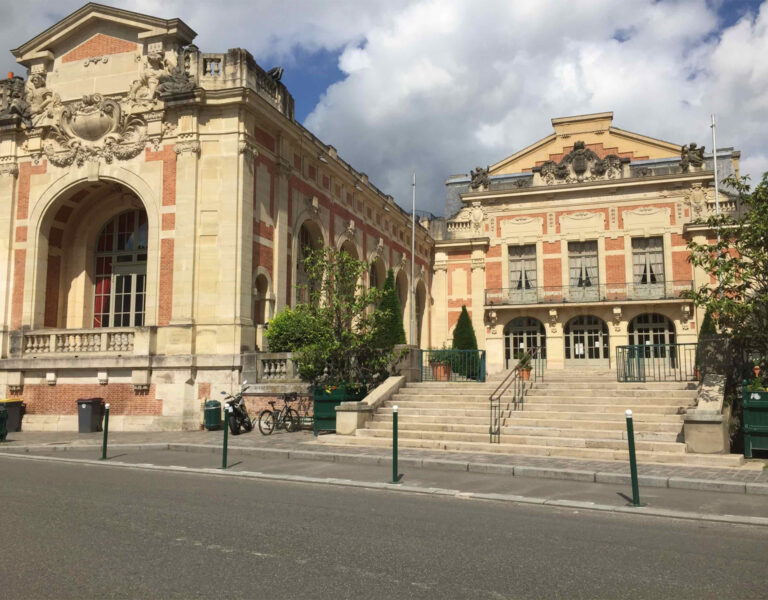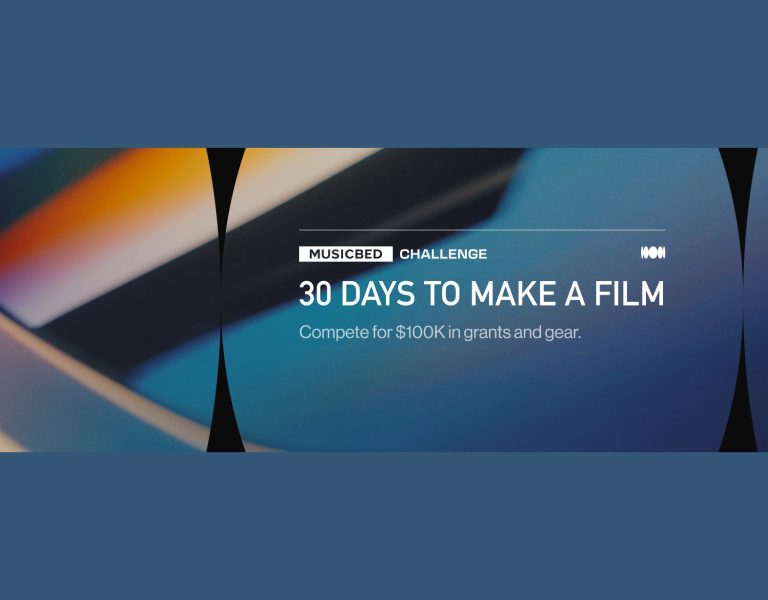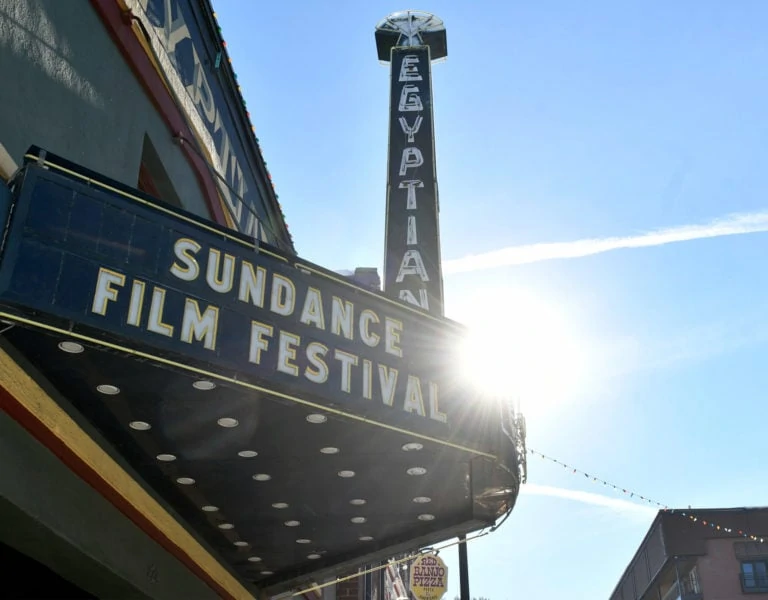Home » Features » Opinion » Across The Pond »
As the shadow of a writers’ strike looms over Hollywood, our Stateside columnist muses on its impact on both sides of the Atlantic. We also hear from the DPs behind upcoming productions Transatlantic, The Wrath of Becky, and Acidman about their camera craft.
And hello again, as we metamorph back from “Award’oeuvres” mode (to which we may return come Emmy time – stay tuned!) into our more usual, “Across the Pond” form, in that stretch of calendar that is often called “Ordinary Time” in the Anglican church.
But the times we inhabit, award season or not, remain far from ordinary.
There is much to catch up on, including from a trio of cinematographers (well, a trio of projects and a quartet of cinematographers, to be precise), but this is also being written and posted right around the time that the Writers’ Guild, on the U.S. side of the pond, may walk out for Hollywood’s first shutdown since the last time they walked out, 15 years ago. Such a shutdown would hit live programming first, and then eventually scripted content, after the banked scripts start running out. Contracts for actors and directors are about to expire too, though those above-the-liners are usually content for the writers to do the walking out first, given their “strikey” reputation and proclivities, and thereby eventually come to terms the other guilds can use as templates.
And as an astute showbiz observer yourself, while you doubtless know all this, note, too, that this spring of Hollywood’s discontent isn’t only about U.S.-based creative folk wanting a bigger slice of streaming revenues for shows they help create, or confronting an era of small episode orders and mini writers’ rooms. While you’re correct that the WGA, like IATSE, doesn’t reach over to the yonder side of the drink, Variety ran an article earlier this month asking “whether British writers, who harbour many of the same concerns as their American counterparts, could ever stage a strike”.

It’s worth a gander. The piece quotes one off-record UK writer who “agreed that a lack of residuals, growing inequality between top talent and jobbing writers and the threat of shows being cancelled, especially late into the production process, were as much a concern on his side of the pond as they are here”.
The article also points out, however, that “writers rooms are less common in the U.K.” than in the U.S. – though that’s changing with shows like Doctor Who – and scribes there can still “often get to hold onto the copyright of their work”, which would be kind of a pipe dream for scripted writing, here in the colonies.
Though while any kind of writers’ stoppage in the UK might be unlikely, the issue of “authorship” brings up the entire spectre of the other large looming issue du jour – which shows every sign of being not just du jour, but du-the-rest-of-our-lives: Namely the role of AI, and its role in writing, “creation”, and other aspects of production (never mind its numerous other dislocations).
AI is already an additional issue in the WGA’s negotiations – as opposed to waiting for next time – though as one astute columnist for Indiewire put it, “generative AI continues to develop so quickly that by the time the WGA agrees on an interpretation, it will be obsolete.” Consider how fast AI and its implications have grown since we were last in “ATP” mode here, before award season.
And now imagine that this won’t be confined to writers. What happens when AI is increasingly used for programming robotic devices, and suddenly, you no longer need people to pull focus, move cameras, or perhaps even operate or hang lights? What happens to the idea of a camera “crew”?
These are open, but very real questions. Which is where we’ll leave this for now – because we’re certain to come back to them. But it would be a disservice not to acknowledge the current precipice that Hollywood finds itself at, in a time much less ordinary than before.
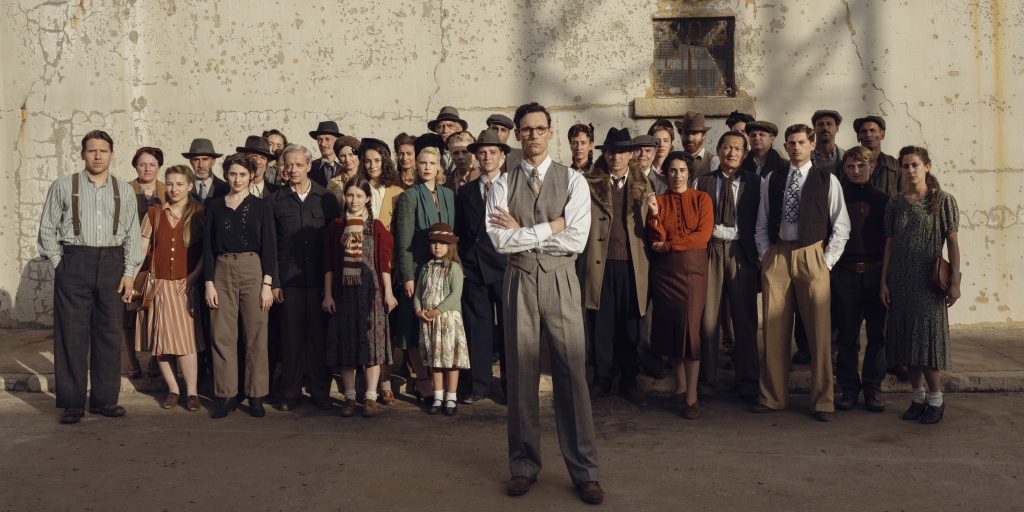
Wartime wonder
However! There is still a lot of interesting work, made in what we might now call “the traditional way”, still worth talking about, as we throw a spotlight on some projects that might be lurking on the edges of various radar screens.
The first of these is the recent Netflix series Transatlantic, a fictionalised look at how American journalist Varian Fry and his Emergency Rescue Committee helped various imperiled artists and writers emigrate to the U.S. via Marseille, in the brief time when such things were still possible during the Vichy government, ahead of America’s entry into World War II.
This often involved the use of smugglers, forged documents, and other wartime improvisations, and the show is chock-a-block with real personages who all risked their lives to escape the brewing fascist peril. Or the previous one, as the case may be.
Cinematographer Wolfgang Thaler AAC had already shot the award-winning Unorthodox for series creator Anna Winger, and relates that when she called to offer him the chance to shoot this latest show, she also asked for a DP recommendation for “block two of the series”, adding that “Anna, and fortunately Netflix, are interested in opening up perspectives for young talents.”
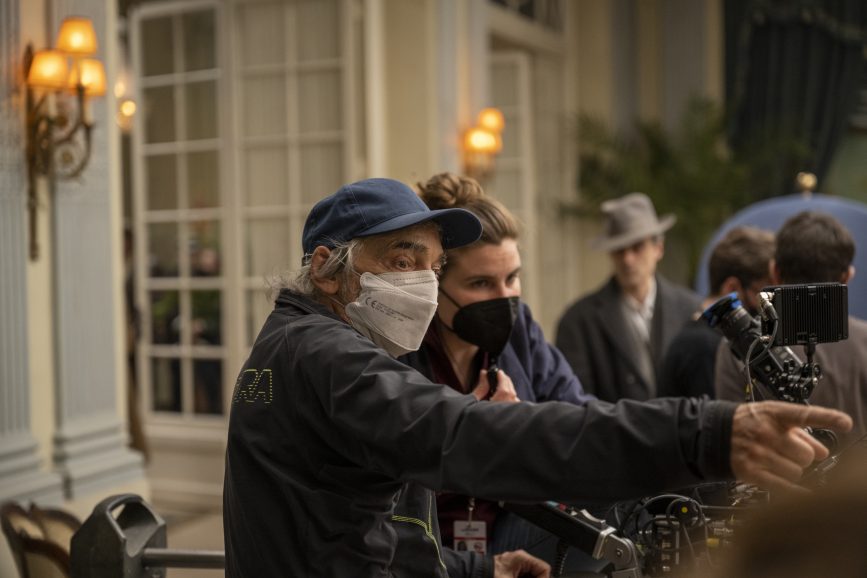
He proposed a certain Sebastian Thaler, who also happens to be his son, adding that he’d worked with him “many times and knows his skills well,” though for his part, Sebastian says that “it wasn’t a given that I would get the job. I had to present my work as a DP to Netflix in order to be accepted on the show,” but once accepted, calls it an “amazing experience and journey”. He’d worked with his father “as 1st camera assistant (1st AC, 2nd AC, etc.) and later on as an operator. This time it was amazing to exchange ideas and to have the chance to create the visual language for the show together.”
As for how that language came together, Sebastian says they “didn’t want a retro look of the ‘40s like desaturated color palettes, but also no smooth, high-gloss digital images. We aimed for a look [..] that combines a modern appearance of the image but at the same time evokes the feeling of something passed.”
To do that, they went to the actual locations involved, “such as the port, the prison camp and the Hotel Splendide”, Wolfgang recounts, working closely with production designer Silke Fischer, another collaborator from Unorthodox. The Splendid, however, “no longer existed as a hotel. Restoring the locations to their 1940 state was a major challenge and required a very close collaboration with the art department […] The lobby which is shown in the series was, when we first arrived there, a theatrical cinema.”
Though there may be a certain metaphor in that, especially as current actors in history seem to always have one eye cocked toward a camera.
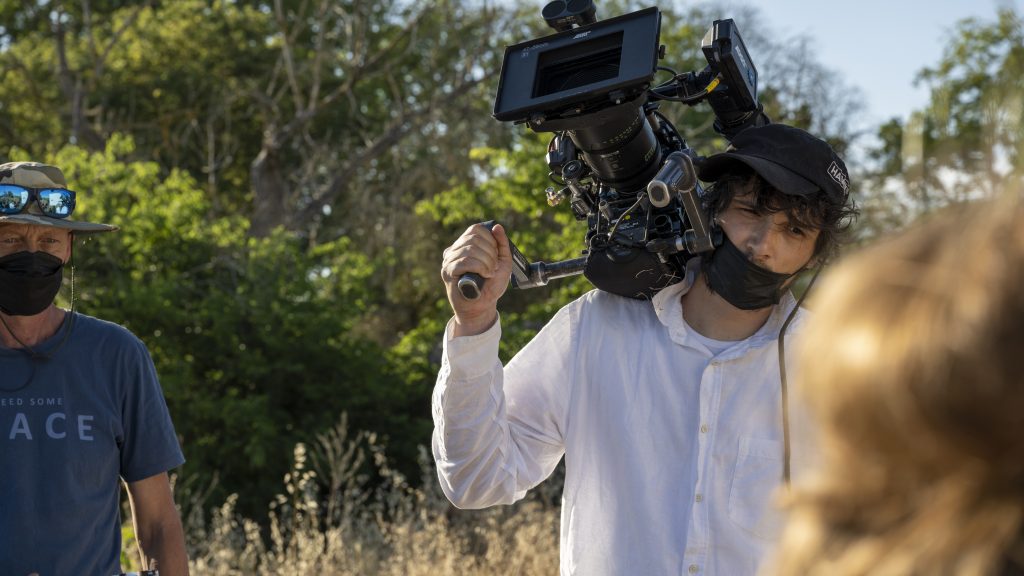
Sebastian also had to take over for Wolfgang in the first block of episodes, when he fell ill with COVID for three weeks during shooting. The two “have a similar aesthetic feeling”, Wolfgang says, “so we complement and support each other.” That aesthetic was captured with an ARRI Alexa Mini LF, using ARRI Signature Primes, and enhanced with Sebastian’s “film emulation project” to capture the feel of specific, old film stocks, by archiving their look, and then recreating them through different LUTs. For Transatlantic, they went with “the Kodak Vision 3 200T 5213 and a universal printing density LUT to still keep a modern feeling.” Since they wanted to further “break the digital image,” they also added “film halation and film grain on the top of the film color emulation. We went with the Signature Primes, to capture the best possible image.”
Being a Netflix show, it also had to be delivered in HDR, but Sebastian said that also paid additional dividends for the show’s visual scope, as they could “still have rendering and texture in windows when you shoot interior scenes. You can see details and the entire outside world in the windows. Which is often a challenge.”
Both from a technical standpoint, and perhaps an emotional one, given the current shape of the “entire outside world” right now.
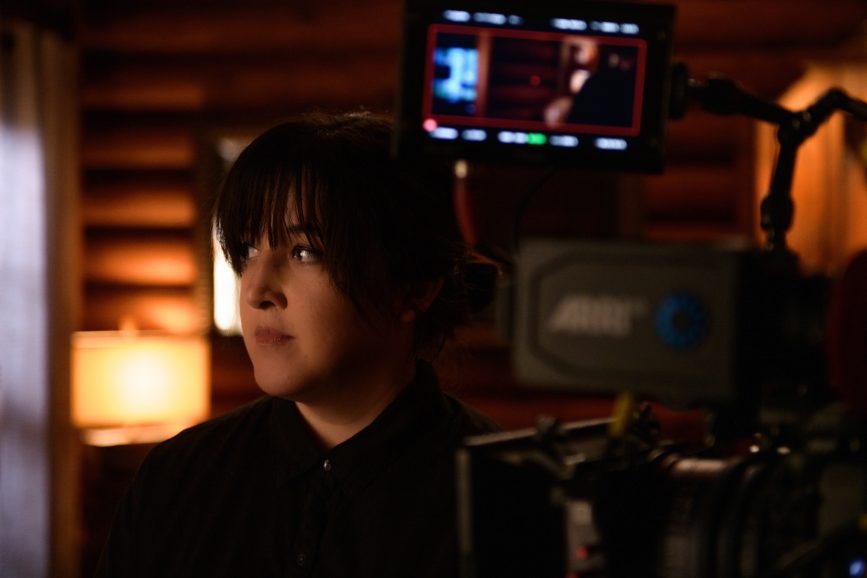
Becky‘s back
Slashing her way through part of that world is the eponymous heroine of the Becky films – indie horror-thrillers that find the titular Becky, played by Lulu Wilson, assuming a near-ninja like proficiency as she takes on neo-Nazis in relentless, often satisfyingly bloody, fashion. Now, in the sequel, The Wrath of Becky, recently debuted at SXSW, her temporary sense of a reclaimed home is shattered when white nationalists come to town, planning the assassination of a U.S. Senator doubtlessly deemed too “woke”.
Once their violence intrudes into Becky’s life – affecting not only her guardian, but her dog, no less – the ninja moves and weaponry come right back out.
Cinematographer Julia Swain – whose Scrambled also premiered at this year’s SXSW – shot the current sequel, taking over from DP Greta Zozula, and working with new director/writers Matt Angel and Suzanne Coote.
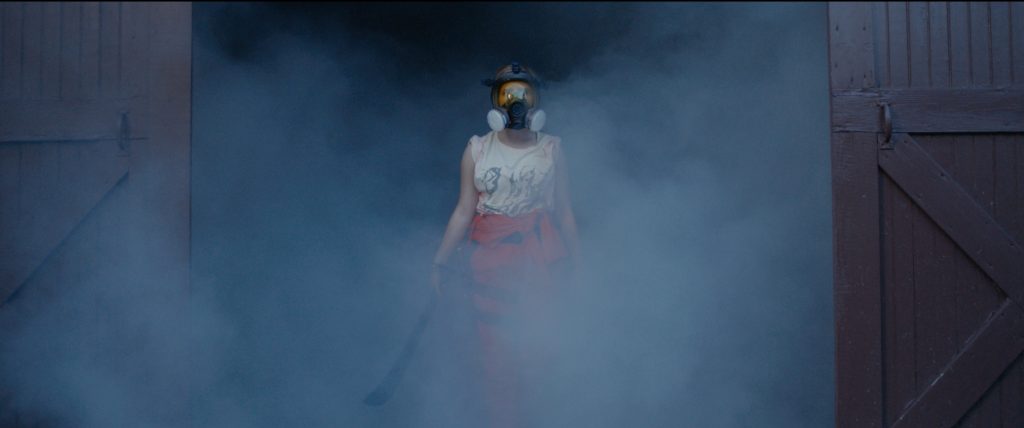
Of them, she says “one of the many things I love about working with Matt and Suz is that they love to move the camera and are so intentional with the rhythm of both the camerawork and the edit. The Wrath of Becky is a very rhythmic film in how it moves from scene to scene and shot to shot. We are only handheld in a few scenes. Everything having to do with camera was very intentional, and I was thrilled to have directors who were enthusiastic about movement and timing.”
Some of that movement was a challenge, since most of the film’s action eventually settles into a single location – a rural cabin compound, where the reactionary mayhem is behind planned, ahead of the unexpected mayhem brought by Becky.
“The cabin also was not that large,” Swain says, “even though it looks like it at times on screen. It still had its limitations in terms of square footage and height. I did love how it allowed me to mix color temperatures. We poured daylight in from the windows while lighting the darker walls that were far from the windows with warm tungsten light. The floorplan allowed us to move across the floors to reveal Becky at a window and do extreme low and high angles. We shot just about every corner of that property.”
Each of those corners was captured with an ARRI Alexa Mini LF with DNA LF primes in 2.39 mode. “I love shooting on the Alexa cameras and know how to push them in any environment,” she says.
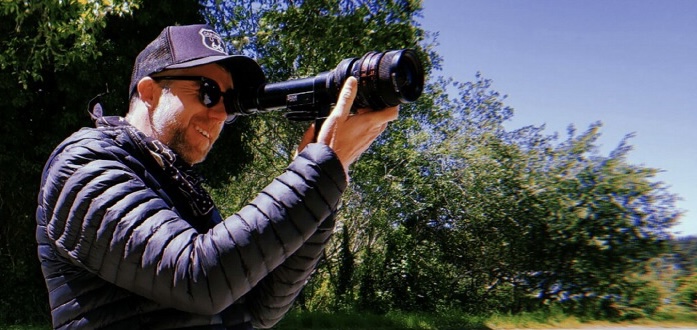
Storytelling with glass
Also pushing ARRI Alexa Minis into new environments is DP John Matyśiak. When we last caught up with him, he’d just shot the word-of-mouth western Old Henry, with Tim Blake Nelson as a frontier widower, busy raising his son, who comes to find his father is not quite who he claims to be.
One might say “continuing” those themes is his recent feature, Acidman, with actor and co-producer Thomas Haden Church, as an estranged father living alone in a mobile home in the Oregon woods. His adult daughter, Dianna Agron, comes for an unannounced visit (and with a secret) of her own – while trying to parse whether her isolated dad is really losing his mind, or actually communicating with the UFO-like lights he sees each night. One might say “continuing”, except that Acidman was shot before Old Henry, the latter in a COVID bubble on a sprawling ranch.
“That film is a pretty long journey,” Matyśiak acknowledges, and it “premiered last year at Tribeca without a distributor”. In the meantime, Matysiak has kept busy, with episodes of the LA Lakers series Winning Time (though that Kareem-and-Magic era squad was actually nicknamed the “Showtime Lakers,” but one understands the former HBO wanting to brand it differently), and the upcoming Big George Foreman biopic.
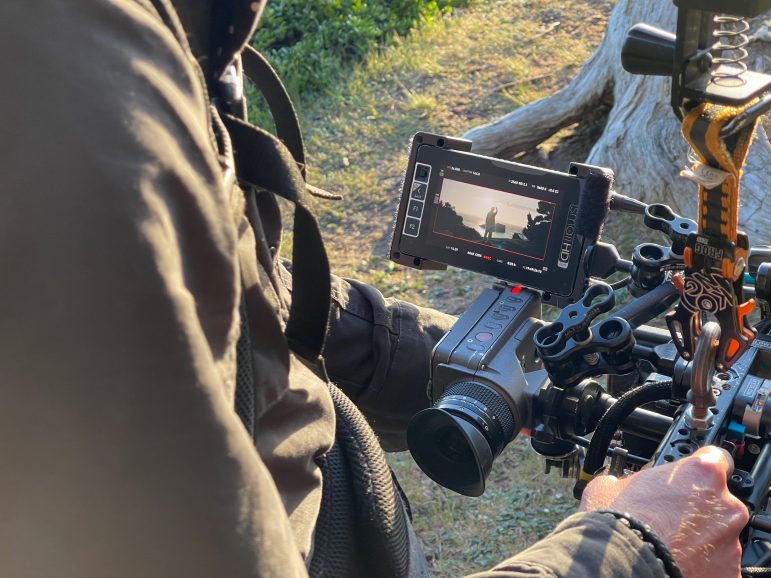
And while Winning Time found him shooting film for the first time in a while as the series strove to recreate a contemporaneous ‘70s/‘80s look, he was back on an Alexa for the Foreman film, and its digital recreations of the boxer’s iconic fights with Muhammad Ali, and others. And while with the celluloid on Winning Time “you knew the film was going to soak (the look and lighting) up. You knew the emulsion was going to breathe an extra ten percent (into it),” on Foreman, they “wanted to really take advantage of the vintage anamorphic” with the Minis working in conjunction with the film’s extensive VFX work, for the “organic, textured look” of its era.
For Acidman’s look he’d also “tested a wide range of vintage anamorphic lenses – looking for particular purple flares”, and was ultimately “reminded of the flairs from the Zeiss Super Speeds,” which he wound up using (along with some Master Primes). “For me, it was like a window into the solar system. Lenses that flare, where you could see the different elements in them, they almost look like solar systems.”
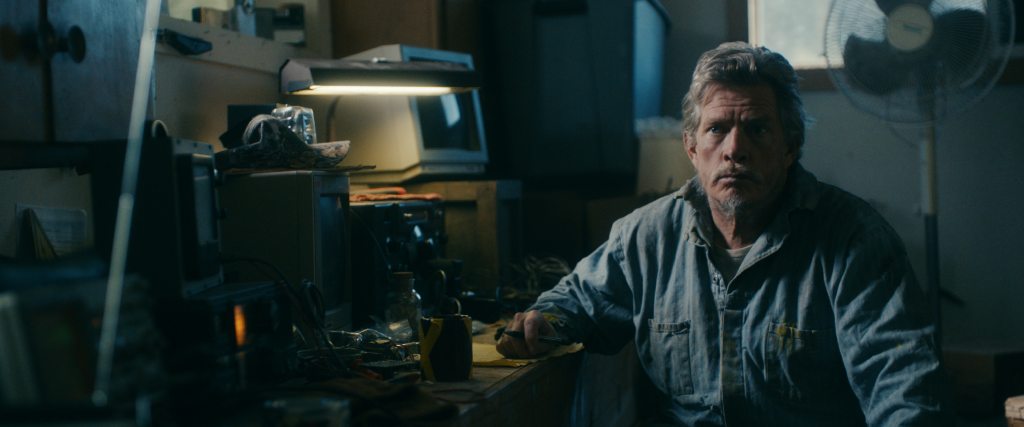
Something that Church’s title character would insist was not only what was intended all along, but perhaps containing its own kind of message – if we just knew how to look for it in the glass.
But then, that’s exactly what cinematographers do.
Meanwhile, more messages, interviews, and a Cine Gear preview – along with a definitive reading on whether Hollywood is on strike! – in our next dispatch. @TricksterInk / AcrossthePondBC@gmail.com







